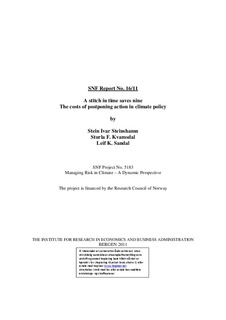A stitch in time saves nine : the costs of postponing action in climate policy
Research report

Åpne
Permanent lenke
http://hdl.handle.net/11250/165331Utgivelsesdato
2011Metadata
Vis full innførselSamlinger
- Reports (SNF) [542]
Sammendrag
The main purpose of this report is to investigate the effects of postponing implementation of a carbon tax assuming that externalities associated with climate change and global warming is real. Failing to internalize these externalities will only lead to a suboptimal situation. The model applied to investigate these externalities starts with the basic relationships, namely supply and demand for fossil fuel, and an added damage term that accounts for the externality. The objective is then to maximize the sum of consumers' and producers' surplus adjusted for the externality. This must be done subject to the dynamic constraint derived from emissions of carbon associated with extraction and consumption of fossil fuel and the natural assimilation of carbon in the atmosphere. The model is solved as a closed loop feedback policy. First the optimal emission path is calculated, and then the corresponding tax path is found. As the externality dealt with here is a pure stock externality it turns out that the optimal tax is equal to the shadow cost of the pollutant.
The dynamic equation for assimilation, or natural decay, of carbon is specified using a fairly sophisticated method, namely the ensemble Kalman filter. Given the relative simplicity of the model with only one type of production and one type of pollutant, this method is supposed to give a best possible estimate of the parameters in the assimilation function.
The main message in this report is that it may possibly be very expensive to postpone implementation of a carbon tax as the tax rate may have to increase by up to 30 per cent and more for each year implementation is postponed in order to recover optimality in the most pessimistic cases. In the more optimistic cases an increase of down to 0.5 per cent per year may be sufficient.